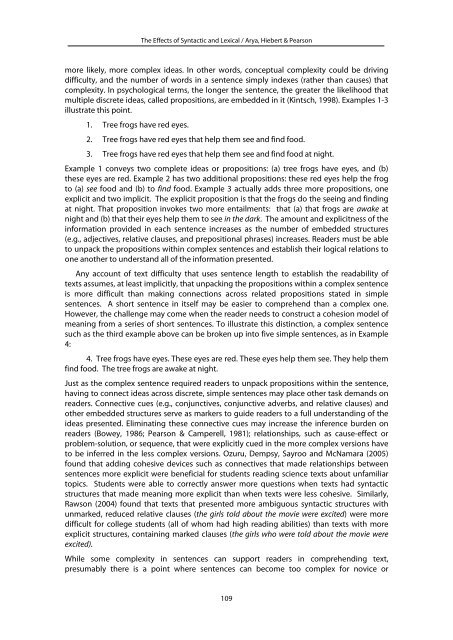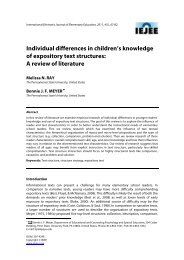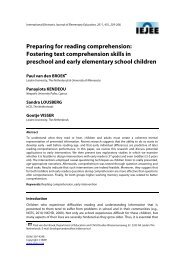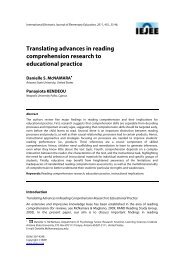The effects of syntactic and lexical complexity on the comprehension ...
The effects of syntactic and lexical complexity on the comprehension ...
The effects of syntactic and lexical complexity on the comprehension ...
You also want an ePaper? Increase the reach of your titles
YUMPU automatically turns print PDFs into web optimized ePapers that Google loves.
<str<strong>on</strong>g>The</str<strong>on</strong>g> Effects <str<strong>on</strong>g>of</str<strong>on</strong>g> Syntactic <str<strong>on</strong>g>and</str<strong>on</strong>g> Lexical / Arya, Hiebert & Pears<strong>on</strong>more likely, more complex ideas. In o<strong>the</strong>r words, c<strong>on</strong>ceptual <str<strong>on</strong>g>complexity</str<strong>on</strong>g> could be drivingdifficulty, <str<strong>on</strong>g>and</str<strong>on</strong>g> <strong>the</strong> number <str<strong>on</strong>g>of</str<strong>on</strong>g> words in a sentence simply indexes (ra<strong>the</strong>r than causes) that<str<strong>on</strong>g>complexity</str<strong>on</strong>g>. In psychological terms, <strong>the</strong> l<strong>on</strong>ger <strong>the</strong> sentence, <strong>the</strong> greater <strong>the</strong> likelihood thatmultiple discrete ideas, called propositi<strong>on</strong>s, are embedded in it (Kintsch, 1998). Examples 1-3illustrate this point.1. Tree frogs have red eyes.2. Tree frogs have red eyes that help <strong>the</strong>m see <str<strong>on</strong>g>and</str<strong>on</strong>g> find food.3. Tree frogs have red eyes that help <strong>the</strong>m see <str<strong>on</strong>g>and</str<strong>on</strong>g> find food at night.Example 1 c<strong>on</strong>veys two complete ideas or propositi<strong>on</strong>s: (a) tree frogs have eyes, <str<strong>on</strong>g>and</str<strong>on</strong>g> (b)<strong>the</strong>se eyes are red. Example 2 has two additi<strong>on</strong>al propositi<strong>on</strong>s: <strong>the</strong>se red eyes help <strong>the</strong> frogto (a) see food <str<strong>on</strong>g>and</str<strong>on</strong>g> (b) to find food. Example 3 actually adds three more propositi<strong>on</strong>s, <strong>on</strong>eexplicit <str<strong>on</strong>g>and</str<strong>on</strong>g> two implicit. <str<strong>on</strong>g>The</str<strong>on</strong>g> explicit propositi<strong>on</strong> is that <strong>the</strong> frogs do <strong>the</strong> seeing <str<strong>on</strong>g>and</str<strong>on</strong>g> findingat night. That propositi<strong>on</strong> invokes two more entailments: that (a) that frogs are awake atnight <str<strong>on</strong>g>and</str<strong>on</strong>g> (b) that <strong>the</strong>ir eyes help <strong>the</strong>m to see in <strong>the</strong> dark. <str<strong>on</strong>g>The</str<strong>on</strong>g> amount <str<strong>on</strong>g>and</str<strong>on</strong>g> explicitness <str<strong>on</strong>g>of</str<strong>on</strong>g> <strong>the</strong>informati<strong>on</strong> provided in each sentence increases as <strong>the</strong> number <str<strong>on</strong>g>of</str<strong>on</strong>g> embedded structures(e.g., adjectives, relative clauses, <str<strong>on</strong>g>and</str<strong>on</strong>g> prepositi<strong>on</strong>al phrases) increases. Readers must be ableto unpack <strong>the</strong> propositi<strong>on</strong>s within complex sentences <str<strong>on</strong>g>and</str<strong>on</strong>g> establish <strong>the</strong>ir logical relati<strong>on</strong>s to<strong>on</strong>e ano<strong>the</strong>r to underst<str<strong>on</strong>g>and</str<strong>on</strong>g> all <str<strong>on</strong>g>of</str<strong>on</strong>g> <strong>the</strong> informati<strong>on</strong> presented.Any account <str<strong>on</strong>g>of</str<strong>on</strong>g> text difficulty that uses sentence length to establish <strong>the</strong> readability <str<strong>on</strong>g>of</str<strong>on</strong>g>texts assumes, at least implicitly, that unpacking <strong>the</strong> propositi<strong>on</strong>s within a complex sentenceis more difficult than making c<strong>on</strong>necti<strong>on</strong>s across related propositi<strong>on</strong>s stated in simplesentences. A short sentence in itself may be easier to comprehend than a complex <strong>on</strong>e.However, <strong>the</strong> challenge may come when <strong>the</strong> reader needs to c<strong>on</strong>struct a cohesi<strong>on</strong> model <str<strong>on</strong>g>of</str<strong>on</strong>g>meaning from a series <str<strong>on</strong>g>of</str<strong>on</strong>g> short sentences. To illustrate this distincti<strong>on</strong>, a complex sentencesuch as <strong>the</strong> third example above can be broken up into five simple sentences, as in Example4:4. Tree frogs have eyes. <str<strong>on</strong>g>The</str<strong>on</strong>g>se eyes are red. <str<strong>on</strong>g>The</str<strong>on</strong>g>se eyes help <strong>the</strong>m see. <str<strong>on</strong>g>The</str<strong>on</strong>g>y help <strong>the</strong>mfind food. <str<strong>on</strong>g>The</str<strong>on</strong>g> tree frogs are awake at night.Just as <strong>the</strong> complex sentence required readers to unpack propositi<strong>on</strong>s within <strong>the</strong> sentence,having to c<strong>on</strong>nect ideas across discrete, simple sentences may place o<strong>the</strong>r task dem<str<strong>on</strong>g>and</str<strong>on</strong>g>s <strong>on</strong>readers. C<strong>on</strong>nective cues (e.g., c<strong>on</strong>junctives, c<strong>on</strong>junctive adverbs, <str<strong>on</strong>g>and</str<strong>on</strong>g> relative clauses) <str<strong>on</strong>g>and</str<strong>on</strong>g>o<strong>the</strong>r embedded structures serve as markers to guide readers to a full underst<str<strong>on</strong>g>and</str<strong>on</strong>g>ing <str<strong>on</strong>g>of</str<strong>on</strong>g> <strong>the</strong>ideas presented. Eliminating <strong>the</strong>se c<strong>on</strong>nective cues may increase <strong>the</strong> inference burden <strong>on</strong>readers (Bowey, 1986; Pears<strong>on</strong> & Camperell, 1981); relati<strong>on</strong>ships, such as cause-effect orproblem-soluti<strong>on</strong>, or sequence, that were explicitly cued in <strong>the</strong> more complex versi<strong>on</strong>s haveto be inferred in <strong>the</strong> less complex versi<strong>on</strong>s. Ozuru, Dempsy, Sayroo <str<strong>on</strong>g>and</str<strong>on</strong>g> McNamara (2005)found that adding cohesive devices such as c<strong>on</strong>nectives that made relati<strong>on</strong>ships betweensentences more explicit were beneficial for students reading science texts about unfamiliartopics. Students were able to correctly answer more questi<strong>on</strong>s when texts had <str<strong>on</strong>g>syntactic</str<strong>on</strong>g>structures that made meaning more explicit than when texts were less cohesive. Similarly,Raws<strong>on</strong> (2004) found that texts that presented more ambiguous <str<strong>on</strong>g>syntactic</str<strong>on</strong>g> structures withunmarked, reduced relative clauses (<strong>the</strong> girls told about <strong>the</strong> movie were excited) were moredifficult for college students (all <str<strong>on</strong>g>of</str<strong>on</strong>g> whom had high reading abilities) than texts with moreexplicit structures, c<strong>on</strong>taining marked clauses (<strong>the</strong> girls who were told about <strong>the</strong> movie wereexcited).While some <str<strong>on</strong>g>complexity</str<strong>on</strong>g> in sentences can support readers in comprehending text,presumably <strong>the</strong>re is a point where sentences can become too complex for novice or109





